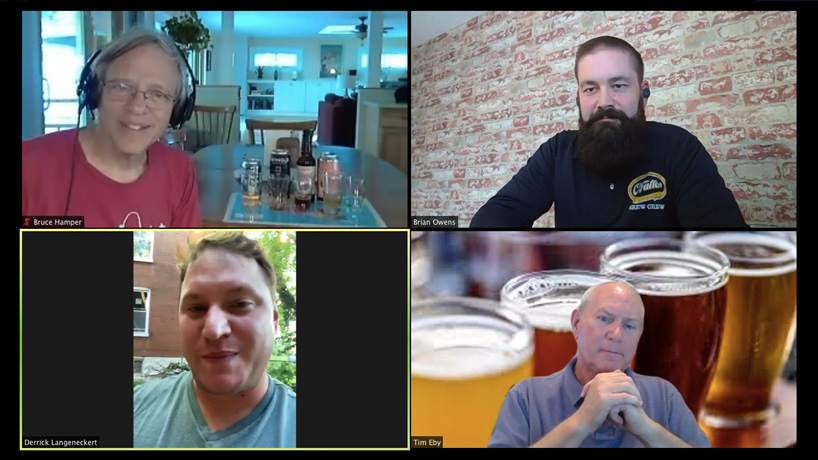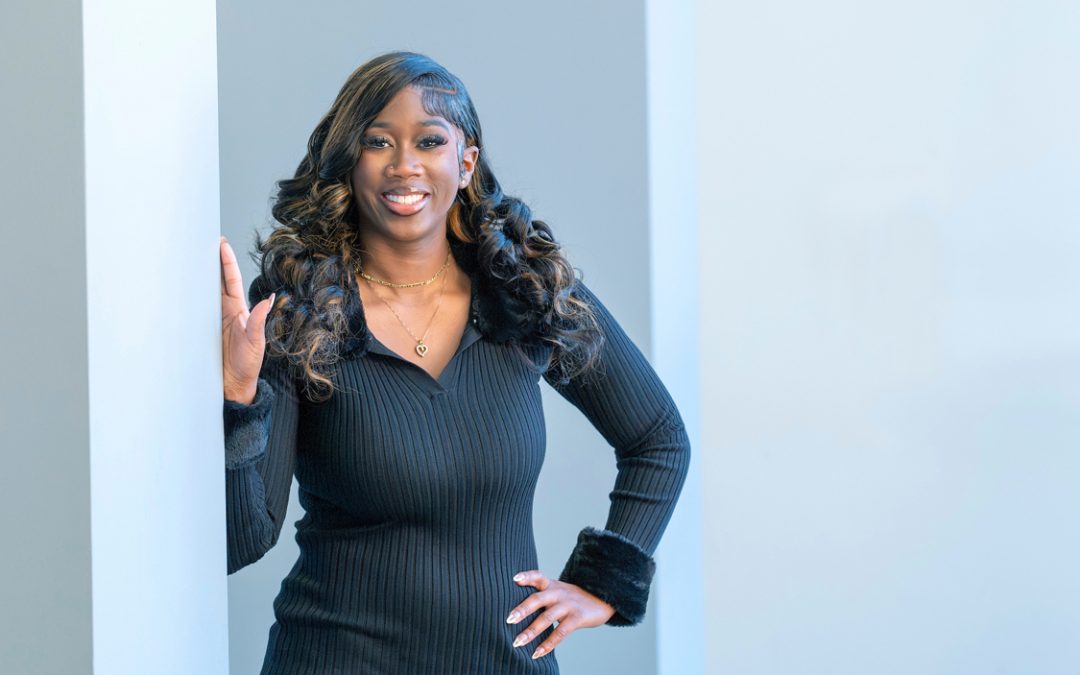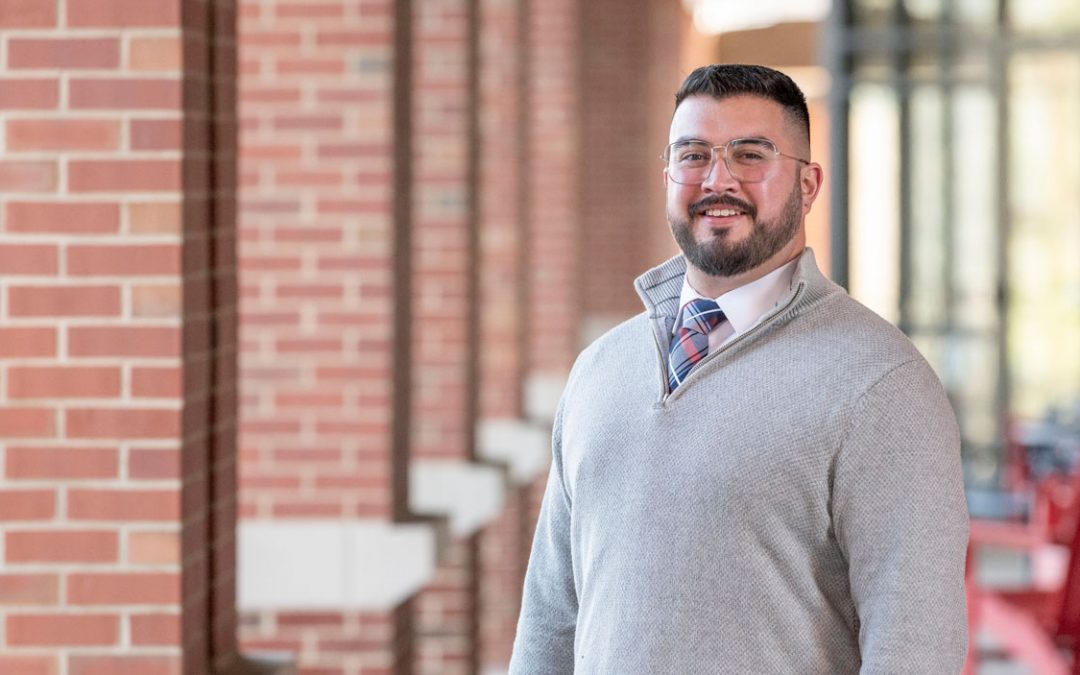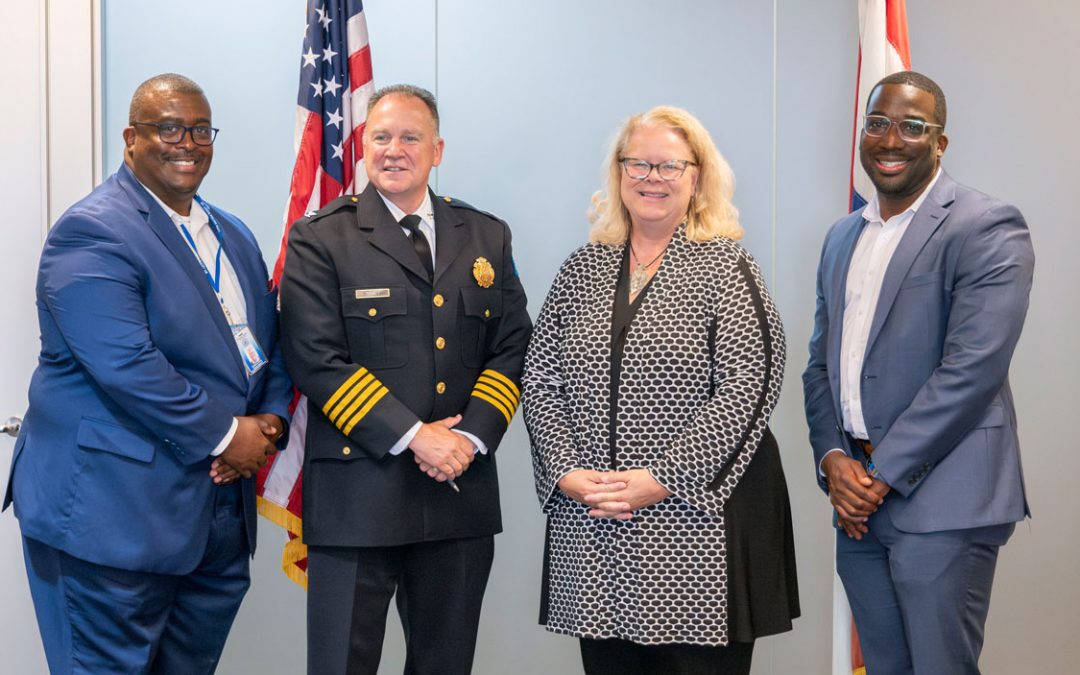
Associate Teaching Professor Bruce Hamper (top left) joined UMSL alumni-turned-brewmasters Brian Owens (top right) of O’Fallon Brewery and Derrick Langeneckert (bottom left) of Alpha Brewing Company for a virtual beer tasting put on by the UMSL Alumni Association. St. Louis Public Radio General Manager Tim Eby (bottom right) served as host for the event on June 11. (Screenshot from Crafts in Your Kitchen virtual beer tasting)
Precautions taken to slow the spread of the coronavirus have made it harder for college friends to gather together and enjoy a beer as the weather warms up.
The University of Missouri–St. Louis Alumni Association created a way to safely revive that rite of summer when it hosted “Crafts in Your Kitchen,” a virtual beer-tasting event held via Zoom conference on June 11.
A total of 138 people registered for the event with 108 of them purchasing $10 sampler packs of five beers from local labels Alpha Brewing Company and O’Fallon Brewery.
Tim Eby, the general manager of St. Louis Public Radio | 90.7 KWMU and a craft beer enthusiast, served as host for the 90-minute tasting session.
“I’ll be guiding you through this program this evening as we enjoy tasting and learning the science and stories behind the beer selections that are chosen by our special guests,” Eby said as he kicked things off.
Those special guests were UMSL graduates-turned-brew masters Derrick Langeneckert (MS Biology, 2016) and Brian Owens (BSBA Marketing, 2002) – of Alpha and O’Fallon, respectively – as well as Bruce Hamper, an associate teaching professor of chemistry and biochemistry who teaches a three-hour course on the chemical and biochemical principles that go into beer brewing and another that dives deeper into the principles of fermentation.
All three offered insights and perspectives into the beer-making process and how it’s evolved with the explosion of craft beer in the past 10-plus years as well as what that’s meant, from a business standpoint, for the beer industry.
Along the way, they led the tasting of those five beers – 3.3 Pale Ale, Bramble Wildberry Kolsch and MargarIPA from O’Fallon and Swingle Lime Blonde Ale and Divine Intervention Blonde Ale from Alpha.
Participants had a chance to chime in with questions via the chat feature as Eby steered the conversation.
Anyone who’s visited the beer aisle at their local grocery story knows there are a lot more breweries stocking the shelves with different styles of beer and unique flavor profiles.
“I think today that it really is similar to the way you think about wines in that they have a full palette of different types of flavors and aromas,” Hamper said. “The hops and the strain of yeast that you have combined in beer can give you just as fascinating a palette comparison.”
A lot of it comes down to the hops – one of the four ingredients essential to making beer, along with grain, water and yeast.
Hops can be a sensitive crop and does best in moderate climates, which is why more than 90 percent of the hops in the United States are grown in the Pacific Northwest. But there’s been increasing production elsewhere lately, and farmers in Washington, Oregon and Idaho have also been coming up with designer strains that create new aromas and flavors.
“There’s been a real growth in the science that’s looking into these hops,” Hamper said. “It’s really tough to nail down exactly what these flavor components can be. There are hundreds of components in them that combined to give you the aroma and the flavors that are produced in a particular line of hops. So there’s a lot of sophisticated analysis. You can use gas chromatography or liquid chromatography with mass spectrometers.”
Most brewers don’t have the equipment necessary to do that analysis, but they don’t need to. They can experiment with different mixtures in small patches to figure out how to get the flavor they’re looking for.
Eby asked Langeneckert and Owens what type of continuing education they need to stay on top of the latest trends in the industry.
“We’ve definitely got to drink a lot of beers,” Langeneckert joked.
Owens agreed and added, “There are so many things going on in craft beer these days. Looking back to Bruce’s point and Derek’s point about designer hops, hops in the past were sold for bitterness. They were sold for the amount of bitterness that they would provide to beer. It’s just recently, in the last 10 to 20 years, where there’s been enough acreage opened up and enough interest in experimenting with these different types of hops and crossbreeding for different aromas.
“The sky’s the limit for the 10,000 breweries around the country that are experimenting and trying to develop and come up with new techniques for these processes.”
The virtual session certainly helped enhance the understanding beer drinkers have for the process of making the product they enjoy so much.
Phil Donato and Mary Bosnick from the Office of Alumni Engagement had the idea for the event and put it together with assistance from Laura Blevins, Chelsea Nollau and Katy Aull from the Office of Executive Events.
At the beginning of June, the alumni engagement, executive events and career services teams collaborated on a virtual networking event for 2020 grads with assistance from 10 alumni.














